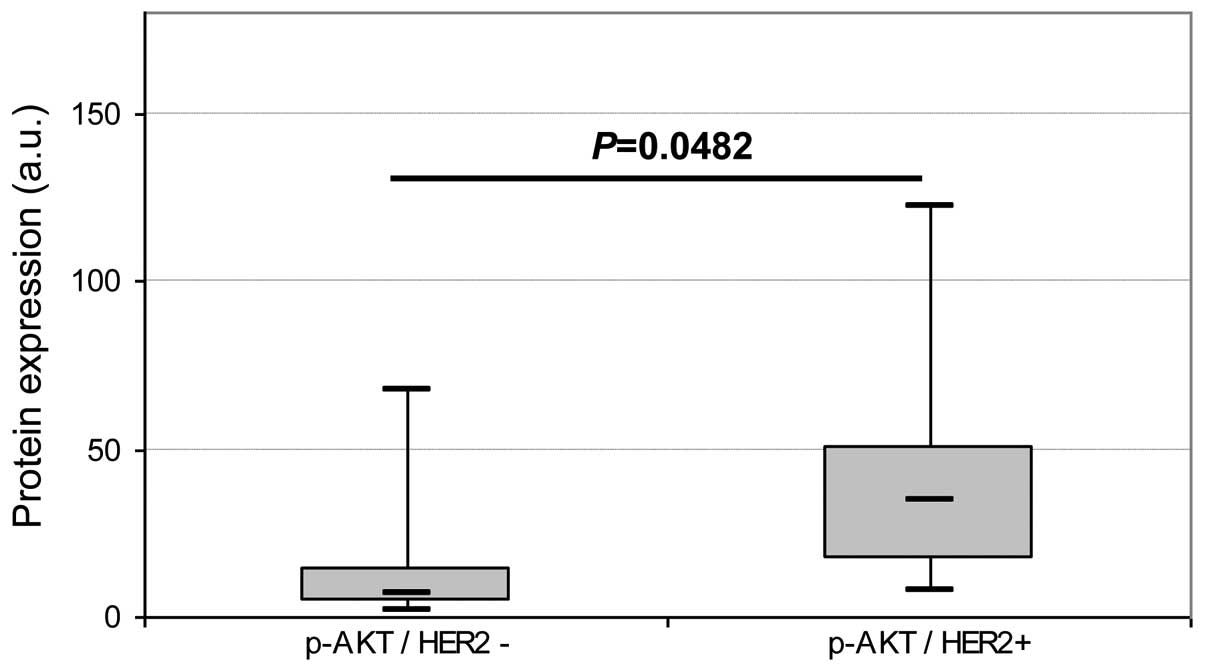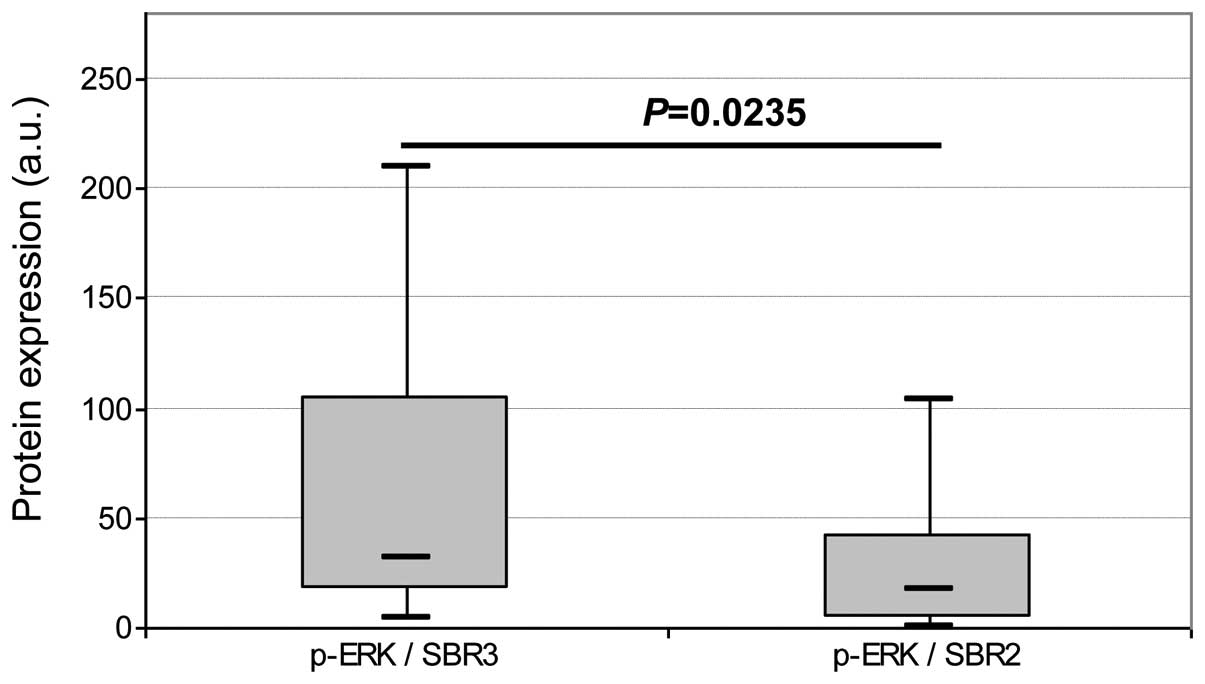|
1
|
Jemal A, Bray F, Center MM, Ferlay J, Ward
E and Forman D: Global cancer statistics. CA Cancer J Clin.
61:69–90. 2011. View Article : Google Scholar
|
|
2
|
Baselga J, Campone M, Piccart M, et al:
Everolimus in postmenopausal hormone-receptor-positive advanced
breast cancer. N Engl J Med. 366:520–529. 2012. View Article : Google Scholar : PubMed/NCBI
|
|
3
|
Maemura M, Iino Y, Koibuchi Y, Yokoe T and
Morishita Y: Mitogen-activated protein kinase cascade in breast
cancer. Oncology. 57(Suppl 2): 37–44. 1999. View Article : Google Scholar
|
|
4
|
Ono K and Han J: The p38 signal
transduction pathway: activation and function. Cell Signal.
12:1–13. 2000. View Article : Google Scholar
|
|
5
|
Frigo DE, Basu A, Nierth-Simpson EN, et
al: p38 mitogen-activated protein kinase stimulates
estrogen-mediated transcription and proliferation through the
phosphorylation and potentiation of the p160 coactivator
glucocorticoid receptor-interacting protein 1. Mol Endocrinol.
20:971–983. 2006. View Article : Google Scholar
|
|
6
|
Wagner EF and Nebreda A: Signal
integration by JNK and p38 MAPK pathways in cancer development. Nat
Rev Cancer. 9:537–549. 2009. View
Article : Google Scholar : PubMed/NCBI
|
|
7
|
Tang L and Han X: The urokinase
plasminogen activator system in breast cancer invasion and
metastasis. Biomed Pharmacother. 67:179–182. 2013. View Article : Google Scholar : PubMed/NCBI
|
|
8
|
Salh B, Marotta A, Wagey R, Sayed M and
Pelech S: Dysregulation of phosphatidylinositol 3-kinase and
downstream effectors in human breast cancer. Int J Cancer.
98:148–154. 2002. View Article : Google Scholar : PubMed/NCBI
|
|
9
|
Esteva FJ, Sahin AA, Smith TL, et al:
Prognostic significance of phosphorylated P38 mitogen-activated
protein kinase and HER-2 expression in lymph node-positive breast
carcinoma. Cancer. 100:499–506. 2004. View Article : Google Scholar : PubMed/NCBI
|
|
10
|
Gutierrez MC, Detre S, Johnston S, et al:
Molecular changes in tamoxifen-resistant breast cancer:
relationship between estrogen receptor, HER-2, and p38
mitogen-activated protein kinase. J Clin Oncol. 23:2469–2476. 2005.
View Article : Google Scholar
|
|
11
|
Davidson B, Konstantinovsky S, Kleinberg
L, et al: The mitogen-activated protein kinases (MAPK) p38 and JNK
are markers of tumor progression in breast carcinoma. Gynecol
Oncol. 102:453–461. 2006. View Article : Google Scholar : PubMed/NCBI
|
|
12
|
Chen L, Mayer JA, Krisko TI, et al:
Inhibition of the p38 kinase suppresses the proliferation of human
ER-negative breast cancer cells. Cancer Res. 69:8853–8861. 2009.
View Article : Google Scholar : PubMed/NCBI
|
|
13
|
Mueller KL, Powell K, Madden JM, Eblen ST
and Boerner JL: EGFR tyrosine 845 phosphorylation-dependent
proliferation and transformation of breast cancer cells require
activation of p38 MAPK. Transl Oncol. 5:327–334. 2012. View Article : Google Scholar : PubMed/NCBI
|
|
14
|
Antoon JW, Bratton MR, Guillot LM, et al:
Pharmacology and anti-tumor activity of RWJ67657, a novel inhibitor
of p38 mitogen activated protein kinase. Am J Cancer Res.
2:446–458. 2012.PubMed/NCBI
|
|
15
|
Ghayad SE, Vendrell JA, Ben Larbi S,
Dumontet C, Bieche I and Cohen PA: Endocrine resistance associated
with activated ErbB system in breast cancer cells is reversed by
inhibiting MAPK or PI3K/Akt signaling pathways. Int J Cancer.
126:545–562. 2010. View Article : Google Scholar : PubMed/NCBI
|
|
16
|
Normanno N, Di Maio M, De Maio E, et al:
Mechanisms of endocrine resistance and novel therapeutic strategies
in breast cancer. Endocr Relat Cancer. 12:721–747. 2005. View Article : Google Scholar : PubMed/NCBI
|
|
17
|
Musgrove EA and Sutherland RL: Biological
determinants of endocrine resistance in breast cancer. Nat Rev
Cancer. 9:631–643. 2009. View
Article : Google Scholar : PubMed/NCBI
|
|
18
|
Cortés J, Saura C, Bellet M, et al: HER2
and hormone receptor-positive breast cancer - blocking the right
target. Nat Rev Clin Oncol. 8:307–311. 2011.PubMed/NCBI
|
|
19
|
Massarweh S, Osborne CK, Creighton CJ, et
al: Tamoxifen resistance in breast tumors is driven by growth
factor receptor signaling with repression of classic estrogen
receptor genomic function. Cancer Res. 68:826–833. 2008. View Article : Google Scholar : PubMed/NCBI
|
|
20
|
Lee H and Bai W: Regulation of estrogen
receptor nuclear export by ligand-induced and p38-mediated receptor
phosphorylation. Mol Cell Biol. 22:5835–5845. 2002. View Article : Google Scholar : PubMed/NCBI
|
|
21
|
Reddy KB, Nabha SM and Atanaskova N: Role
of MAP kinase in tumor progression and invasion. Cancer Metastasis
Rev. 22:395–403. 2003. View Article : Google Scholar : PubMed/NCBI
|
|
22
|
Chen J, Baskerville C, Han Q, Pan ZK and
Huang S: α(v) integrin, p38 mitogen-activated protein kinase, and
urokinase plasminogen activator are functionally linked in invasive
breast cancer cells. J Biol Chem. 276:47901–47905. 2001.
|
|
23
|
Kim MS, Lee EJ, Kim HR and Moon A: p38
kinase is a key signaling molecule for H-Ras-induced cell motility
and invasive phenotype in human breast epithelial cells. Cancer
Res. 63:5454–5461. 2003.PubMed/NCBI
|
|
24
|
Qi X, Zhi H, Lepp A, et al: p38γ
mitogen-activated protein kinase (MAPK) confers breast cancer
hormone sensitivity by switching estrogen receptor (ER) signaling
from classical to nonclassical pathway via stimulating ER
phosphorylation and c-Jun transcription. J Biol Chem.
287:14681–14691. 2012.
|
|
25
|
Banerjee A, Koziol-White C and Panettieri
R Jr: p38 MAPK inhibitors, IKK2 inhibitors, and TNFα inhibitors in
COPD. Curr Opin Pharmacol. 12:287–292. 2012.
|
|
26
|
Chergui F, Chrétien AS, Bouali S, et al:
Validation of a phosphoprotein array assay for characterization of
human tyrosine kinase receptor downstream signaling in breast
cancer. Clin Chem. 55:1327–1336. 2009. View Article : Google Scholar : PubMed/NCBI
|
|
27
|
Svensson S, Jirström K, Rydén L, et al:
ERK phosphorylation is linked to VEGFR2 expression and Ets-2
phosphorylation in breast cancer and is associated with tamoxifen
treatment resistance and small tumours with good prognosis.
Oncogene. 24:4370–4379. 2005. View Article : Google Scholar : PubMed/NCBI
|
|
28
|
Bhatt S, Xiao Z, Meng Z and
Katzenellenbogen BS: Phosphorylation by p38 mitogen-activated
protein kinase promotes estrogen receptor α turnover and functional
activity via the SCF(Skp2) proteasomal complex. Mol Cell Biol.
32:1928–1943. 2012.
|
|
29
|
Meng F, Zhang H, Liu G, et al: p38γ
mitogen-activated protein kinase contributes to oncogenic
properties maintenance and resistance to poly
(ADP-ribose)-polymerase-1 inhibition in breast cancer. Neoplasia.
13:472–482. 2011.
|
|
30
|
Qi X, Hou S, Lepp A, et al:
Phosphorylation and stabilization of topoisomerase IIα protein by
p38γ mitogen-activated protein kinase sensitize breast cancer cells
to its poison. J Biol Chem. 286:35883–35890. 2011.
|
|
31
|
Milde-Langosch K, Bamberger AM, Rieck G,
et al: Expression and prognostic relevance of activated
extracellular-regulated kinases (ERK1/2) in breast cancer. Br J
Cancer. 92:2206–2215. 2005. View Article : Google Scholar : PubMed/NCBI
|
|
32
|
Linderholm BK, Hellborg H, Johansson U,
Skoog L and Lehtiö J: Vascular endothelial growth factor receptor 2
and downstream p38 mitogen-activated protein kinase are possible
candidate markers of intrinsic resistance to adjuvant endocrine
treatment in steroid receptor-positive breast cancer. Breast Cancer
Res Treat. 125:457–465. 2011. View Article : Google Scholar
|
|
33
|
Hermanto U, Zong CS and Wang LH:
Inhibition of mitogen-activated protein kinase kinase selectively
inhibits cell proliferation in human breast cancer cells displaying
enhanced insulin-like growth factor I-mediated mitogen-activated
protein kinase activation. Cell Growth Differ. 11:655–664.
2000.
|
|
34
|
Park SS and Kim SW: Activated Akt
signaling pathway in invasive ductal carcinoma of the breast:
Correlation with HER2 overexpression. Oncol Rep. 18:139–143.
2007.PubMed/NCBI
|

















